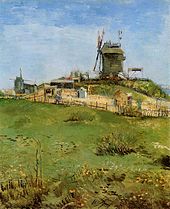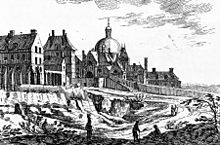
Montmartre
Montmartre (UK: /mɒnˈmɑːrtrə/ mon-MAR-trə,[1][2][3] French: [mɔ̃maʁtʁ] (![]() listen)) is a large hill in Paris‘s northern 18th arrondissement. It is 130 m (430 ft) high and gives its name to the surrounding district, part of the Right Bank. Montmartre is primarily known for its artistic history, for the white-domed Basilica of the Sacré-Cœur on its summit, and as a nightclub district.
listen)) is a large hill in Paris‘s northern 18th arrondissement. It is 130 m (430 ft) high and gives its name to the surrounding district, part of the Right Bank. Montmartre is primarily known for its artistic history, for the white-domed Basilica of the Sacré-Cœur on its summit, and as a nightclub district.
The other church on the hill, Saint Pierre de Montmartre, built in 1147, was the church of the prestigious Montmartre Abbey. On 15 August 1534, Saint Ignatius of Loyola, Saint Francis Xavier and five other companions bound themselves by vows in the Martyrium of Saint Denis, 11 Rue Yvonne Le Tac, the first step in the creation of the Jesuits.[4]
Near the end of the 19th century and at the beginning of the 20th, during the Belle Époque, many artists lived, worked, or had studios in or around Montmartre, including Amedeo Modigliani, Claude Monet, Pierre-Auguste Renoir, Edgar Degas, Henri de Toulouse-Lautrec, Suzanne Valadon, Piet Mondrian, Pablo Picasso, Camille Pissarro and Vincent van Gogh. Montmartre is also the setting for several hit films.
The area is served by Métro, with Line 2 stations at Barbès–Rochechouart, Anvers, Pigalle and Blanche, Line 4 stations at Château Rouge and Barbès–Rochechouart, as well as Line 12 stations at Pigalle, Abbesses, Lamarck–Caulaincourt and Jules Joffrin. It is also served by the Montmartre Funicular. The historic district established by the City of Paris in 1995 is bordered by Rue Caulaincourt and Rue Custine on the north, the Rue de Clignancourt on the east and the Boulevard de Clichy and Boulevard de Rochechouart to the south,[5] containing 60 ha (150 acres).[6]
Etymology
The toponym Mons Martis, Latin for “Mount of Mars”, survived into Merovingian times, gallicised as Montmartre.[7]
History

Saint-Pierre de Montmartre (originally 1133, much of it destroyed in 1790 and rebuilt in the 19th century) seen from the dome of the Basilica of the Sacré-Cœur

The Moulin de la Galette, painted by Vincent van Gogh in 1887 (Carnegie Museum of Art)
Archaeological excavations show that the heights of Montmartre were occupied from at least Gallo-Roman times. Texts from the 8th century cite the name of mons Mercori (Mount Mercury); a 9th-century text speaks of Mount Mars. Excavations in 1975 north of the Church of Saint-Pierre found coins from the 3rd century and the remains of a major wall. Earlier excavations in the 17th century at the Fontaine-du-But (2 rue Pierre-Dac) found vestiges of Roman baths from the 2nd century.[5]
The butte owes its particular religious importance to the text entitled Miracles of Saint-Denis, written before 885 by Hilduin, abbot of the monastery of Saint-Denis, which recounted how Saint Denis, a Christian bishop, was decapitated on the hilltop in 250 AD on orders of the Roman prefect Fescennius Sisinius for preaching the Christian faith to the Gallo-Roman inhabitants of Lutetia. According to Hilduin, Denis collected his head and carried it as far as the fontaine Saint-Denis (on modern impasse Girardon), then descended the north slope of the hill, where he died. Hilduin wrote that a church had been built “in the place formerly called Mont de Mars, and then, by a happy change, ‘Mont des Martyrs’.”[5]
In 1134, king Louis VI purchased the Merovingian chapel and built on the site the church of Saint-Pierre de Montmartre, still standing. He also founded the Royal Abbey of Montmartre, a monastery of the Benedictine order, whose buildings, gardens and fields occupied most of Montmartre. He also built a small chapel, called the Martyrium, at the site where it was believed that Saint Denis had been decapitated. It became a popular pilgrimage site. In the 17th century, a priory called abbaye d’en bas was built at that site, and in 1686 it was occupied by a community of nuns.[5]
The abbey was destroyed in 1790 during the French Revolution, and the convent demolished to make place for gypsum mines. The church of Saint-Pierre was saved. At the place where the chapel of the Martyrs was located (now 11 rue Yvonne-Le Tac), an oratory was built in 1855. It was renovated in 1994.[5]
By the 15th century, the north and northeast slopes of the hill were the site of a village surrounded by vineyards, gardens and orchards of peach and cherry trees. The first mills were built on the western slope in 1529, grinding wheat, barley and rye. There were thirteen mills at one time, though by the late nineteenth century only two remained,[5]





















